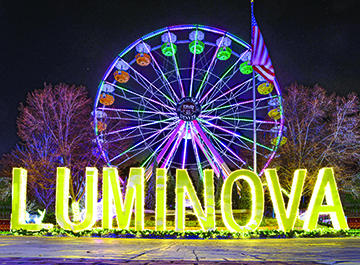
by Mark Smiley | Dec 17, 2021 | Main Articles
by Mark Smiley

Candy Cane Tunnel: The candy cane tunnel is a must see when visiting Elitch Gardens this holiday season.
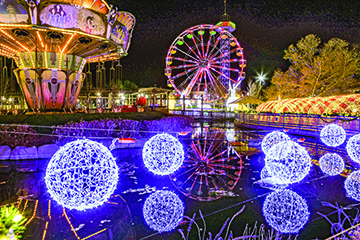
Rides: A limited amount of rides are open at Elitch Gardens during the Luminova Holidays event.
 Luminova Holidays at Elitch Gardens premiered on November 26, 2021, and runs through Sunday, January 2, 2022. For the first time ever, the park transformed into Luminova Holidays and delivered a winter wonderland experience with larger-than-life holiday displays featuring over three million lights and more.
Luminova Holidays at Elitch Gardens premiered on November 26, 2021, and runs through Sunday, January 2, 2022. For the first time ever, the park transformed into Luminova Holidays and delivered a winter wonderland experience with larger-than-life holiday displays featuring over three million lights and more.
The immersive family experience features a display of glittering lights, fun rides, memory-making moments, and visits with St. Nick. Reservations are required. The event will run evenings from 5 p.m. to 10 p.m.
“We truly are proud and excited to introduce the first-ever holiday event at the Park,” says David Dorman, Elitch Gardens General Manager. “Luminova Holidays promises to be a must-see, sensational, and sophisticated spectacle, and a must-do for Coloradans of all ages to make lifelong memories at Elitch Gardens.”
Luminova Holidays featured at Elitch Gardens includes a 65 ft. Christmas tree, 25 ft. snowman that never melts, 200 ft. candy cane tunnel, ornaments and presents scaling over 16 ft. tall, rides on limited Elitch Gardens attractions, strolling holiday entertainers, and interactive activities, including light-up hopscotch.

Three Million Lights: Luminova Holidays features over three million lights throughout the park.
“This year more than ever we want families and friends to create memories that will last well beyond the holiday season,” says Dixie Baker, co-producer of Luminova Holidays. “We are extremely excited to be making our Colorado debut and to share with Denver the joy and holiday cheer that thousands have experienced when coming to see Luminova! We are thrilled to be partnering with Elitch Gardens and look forward to brightening up your holidays for years to come.”
President and CEO of VISIT DENVER, Richard Scharf, further adds, “We are thrilled that Luminova Holidays has chosen Denver and Elitch Gardens for their newest attraction. The holiday season in the Mile High City is always an exciting time with shopping, festive attractions, performances, and displays, and we look forward to adding another unique tradition for families to enjoy downtown.”
Visit ElitchGardens.com/Luminova to reserve your visit and purchase tickets. Follow them on Facebook and Instagram – @LuminovaHolidays and @ElitchGar dens, and Twitter – @LuminovaHoliday and @ElitchGardens.
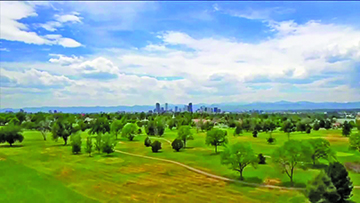
by Charles Bonniwell | Nov 19, 2021 | Main Articles
Developer Still Seeks Commercialization With Help Of Hancock Administration
by Charles Bonniwell

From Above: An aerial view of the entire 155-acre Park Hill Golf Course area under threat of commercialization from developer Westside Investment Partners and the Hancock Administration.
The voters appeared to overwhelmingly state that they wanted the 155-acre Park Hill Golf Course area to remain green space. By an almost 2-to-1 margin, voters approved Initiated Ordinance 301 which required citywide voter approval to build on the land. The initiative and the campaign were headed up by former mayoral candidate Penfield Tate III, who headed up Save Open Space Denver (“SOS Denver”), and former Denver mayor and Park Hill resident Wellington Webb. The slogan of the campaign was “Green over Concrete.”
Tate indicated that the message hit home for residents who have seen massive new density across Denver, supported with the direct and indirect support of Denver Mayor Michael Hancock. The developer, Westside Investment Partners (“Westside”) bought the property in 2019 for $24 million from Clayton Early Learning. Westside put up its own Initiative 302 which was almost exactly the same as 301 but exempted golf courses from the definition of a conservative easement. The net effect of 301 and 302 passing would allow the developer to proceed with development of Park Hill, notwithstanding the passage of 301. Tate indicated that he was pleased that the voters were not fooled by Westside’s tricky, similar sounding Initiative.
Visioning Process
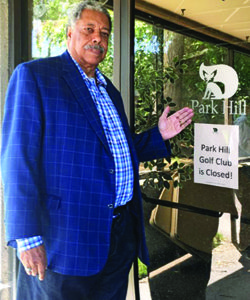
Still Leading: Former Denver mayor Wellington Webb, a Park Hill resident, has help to lead the fight to stop the commercialization of the Park Hill Golf Course area.

Still Under Threat: Notwithstanding an overwhelming 2-to-1 vote in Ballot Initiative 301 and 302 to require a city-wide vote before lifting a conservation easement on the 155 acre Park Hill Golf Course, developer Westside Investment Partners with the strong backing of the Hancock Administration and taxpayer dollars is moving full steam ahead to try to commercialize the green space.
The battle continues with Hancock and Westside trying to figure out how to outmaneuver Webb and Tate and the citizens who want more and not less open space. Some say the Hancock Administration has gone to extraordinary lengths to help Westside. In what critics contend was a contrived lawsuit, Westside sued the city over a drainage easement on the land. In settlement, the city provided an enormous war chest of $6 million for Westside to fight citizen groups like SOS Denver. That agreement gives Westside a three-year window for a public engagement process (i.e., a public relations campaign).
The city set up an expensive Denver taxpayer funded “Park Hill Golf Course Area Visioning Process” which basically plans the commercial development on behalf of Westside with a 27-member Park Hill Steering Committee. It appears that the Steering Committee is largely composed of apparently pro-development members.
Another Lawsuit
SOS Denver’s response was to file a lawsuit against Mayor Hancock and the City and County of Denver in June 2021 that alleges the public planning process is illegal until the conservation easement is lifted.
“The city has to follow the law. That’s the whole point of our lawsuit,” declared Tate. He stated the entire public engagement process was a sham and a waste of taxpayer dollars. The city issued a statement that the Park Hill planning process was a very standard one and that gathering community input for future use did not in any way interfere with the conservation easement.

The Good, The Bad, And The Ugly: Attorney and former mayoral candidate Penfield Tate Hill III, below, headed up Save Open Space Denver and helped win Ballot Initiative 301 and defeat Ballot Initiative 302 proposed by Westside Investment Partners (“Westside”) whose public face is Kenneth Ho, above. Ho was supported by Park Hill Steering Committee member Pastor Del Phillips, right, who claimed green open space in Park Hill is somehow racist and who is considered by his critics to be little more than a shill for Westside.
Holleran Group’s (Westside’s partner) CEO & Managing Partner Norman Harris indicated that it was not slowing down due to the overwhelming vote of Denver’s citizens. With a massive fortune to be made if the conservation easement on Park Hill can be eliminated, Holleran proclaimed it to be a visioning process, in a story published by The Denverite:
“We are going to double down on our community outreach to assure that we are bringing the right folks to the table and truly achieve an equitable outcome,” Harris said. “We’re very confident that we are going to be successful, and we just really look forward to the opportunity to bring more people into the conversation.”
Park Hill Steering Committee head Pastor Del Phillips indicated that preventing the commercial development was racist in nature given the history of Park Hill. He stated at a rally in October:
“I think it is highly unusual how people say this is about saving green space… This is really about people who believe they have the right to choose where other folks want to live.”
Kenneth Ho of Westside did not see the 2-to-1 vote against its initiative as a loss for the commercial development of Park Hill but rather: “We understand that residents want to hear more details about what this can be.” He went on to declare: “I think what the initiative does is it now says we need to come up with a plan for the voters to vote on. I think the next step is to develop that and put some specifics around the plan.”
What’s Next

Pastor Del Phillips
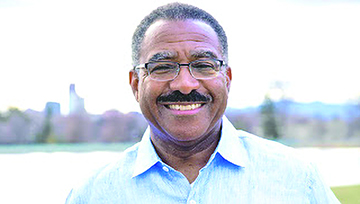
Penfield Tate Hill III
The Steering Committee is expected to provide the city its recommendations by Thanksgiving in the form of a Vision Summary which is expected to be very pro developer and little more than a glossed over version of what Westside wants. It will be used to give pro developer recommendations to the Denver City Council by the Community Planning and Development department which is controlled by the Hancock Administration.
SOS Denver indicates it is ready for the fight first at the City Council level and if that fails on a second ballot measure now required by Initiative 301 to lift the conservation easement.
Wellington Webb declared: “For me, what’s next is to get reengaged with my Nuggets tickets. Then we go back and look at what are the areas for reconciliation to some degree.”

by Regan Bervar | Nov 19, 2021 | Main Articles
“They say the universe is expanding. That should help with the traffic.”
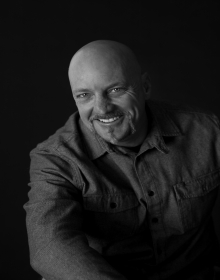 by Luke Schmaltz
by Luke Schmaltz
Over the past two decades, Denver has undergone a high-speed growth spurt, transforming from an adolescent urban sprawl to a metropolitan powerhouse of international renown.
The spoils of rapid growth are not without consequence, however, as infrastructure scrambles to keep up with influx. One of the negative results — experienced by anyone who travels the Mile High City streets in a moving vehicle — is profound traffic congestion.
The next time you’re sitting in 3:45 p.

Echo3 electric vehicles are enclosed, designed for three adults and classified in Denver as scooters.
m. pre-rush hour traffic as your idling car burns gasoline, make note of your reaction when the inevitable hipster on an electric scooter zips past you and your stranded peers and continues along to their destination. As you languish in an automotive bottleneck, resenting the efficiency with which someone half your age goes twice your speed for a fraction of the money, consider that — just maybe — they might be onto something.
In addition to presenting a profound solution to global warming (EVs produce zero tailpipe emissions and far fewer life cycle emissions), electric vehicles may hold the key to reducing traffic jams. Sure, the hipster scooter or e-bike may not be your cup of small-batch, hand-crafted tea, but there are other options in the EV market that may shorten and simplify your daily drive time. Plus, over the long haul, EVs can most certainly save you money. Ultimately, EVs present several advantages that could, if adopted by a significant number of residents, put a dent in a traffic problem and pollution level that ranks Denver as one of the worst cities to drive and breathe in.
Sharable EVs: Bikes and Scooters
(App-guided Acquisition)
Currently, just two vendors have been authorized by Denver City Council to operate bike and scooter services across the city. Lime and Lyft were awarded contracts while other vendors — some in business locally since 2018 — have been forced to hit the road. Politics notwithstanding, the availability of these recently-dubbed “micromobility” products has been and will be critical to reducing traffic — especially for folks with errands and work commutes that are relatively close to home. Rather than fire up the ol’ gas guzzler to go to the post office down the street and back, a quick trip on a shared EV can get the job done at the same time at a fraction of the cost and with little or no stoplight migraines or parking nightmares. OK, so you might look a little silly slogging to a meeting on a souped-up kick’n’go while your fellow citizens slosh snow and mud all over your tailored suit, but there are weatherproof upgrades for determined conservationists.
In addition to being incredibly convenient, micromobility transportation creates zero carbon emissions, zero noise pollution, can be parked anywhere, and may also be offsetting the collective occupancy of RTD systems. You will never, ever sit in a traffic jam on one of these EVs. Among the down sides is that while they do not require a license to operate, you must be 16 years of age.
Echo3 EVs
(329 Santa Fe Dr., Denver, CO 80223)
In a promotional YouTube video sponso

High-end Electric Cars appeal to environmentally conscious who can’t stand to be seen on a scooter.
red by Colorado & Company/KUSA TV, Echo3 President Rex Halbeisen urges Denver residents to “reevaluate your short trip transportation.” The company delivers, designs and manufactures “the world’s most efficient electric vehicles.” Halbeisen continues with an interesting metric, “78.5% of trips you take are within three miles of your house.” This data demonstrates that three of every four times you fire up your combustion engine vehicle may be unnecessary. Instead, the errand can be accomplished in one of Echo3’s sleek, enclosed, three passenger, scooter-like vehicles. In Colorado, these EVs are classified as low-powered scooters, meaning insurance rates pale in comparison to those of a car, truck, or SUV. It doesn’t take much imagination to realize that a gridlock traffic jam situation where even a fraction of the vehicles are Echo3s is dang-near impossible.
Meanwhile, company marketing director Madeline Espinoza describes more ways in which Echo3 EVs can help reduce everyday vehicle-related headaches. “They go 35 mph, so road rage is impossible,” she begins. “They are street legal, yet you can park them on the sidewalk just like an electric scooter. The benefit of these vehicles is they are enclosed, so they can be used year-round, and I even have snow chains for them. And, if you’re in the city just trying to bop around, this is a really efficient way to do so” she explains.
While never having to shell out money for gas and carrying very affordable insurance are standout benefits, the ability to simply park on the sidewalk is reason enough by itself to entice any longtime Denverite. Espinoza also points out that an Echo3 is cheaper than an RTD pass, offers a reduced-stress driving experience and is even ideal for rural areas. “I drive mine from Littleton to our dealership on Santa Fe Drive. I just take Broadway all the way up,” she says.
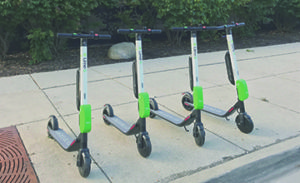
When Denver gives you these Limes, you just might get to work on time.

Echo3 demonstrates the advantage of their EVs over traditional combustion engine automobiles.
(257 Fillmore St., Denver, CO 80206)
This new line of EVs developed by Volvo and Geely was launched in 2017 from the former’s headquarters in Gothenburg, Sweden. Concerning user experience, Business Insider recently reported, “The interior is built to be something an actual human would use and enjoy — not a button-free, avant-garde exercise in alternative design. This is the all-new Polestar 2, you see, and it drives like a finished version of the [Tesla] Model 3.” The January, 2021, review also praises the Polestar 2 as “more substantive, more satisfying,” so perhaps this product may offset the propensity for road rage due to extremely satisfied and subdued drivers. At any rate, despite the potential sticker shock some buyers may experience, the company’s goals are noble. Polestar’s Head of Sustainability, Fredrika Klarén explains, “As an electric car maker, we don’t have to worry about combustion engines producing toxic emissions, but that doesn’t mean our job is done. Now we must focus all our efforts on cutting emissions in the supply chain and in the production of our cars. This is a historic and exciting time for car makers, an opportunity to seize the moment and do better. For the first time, we can dare to dream about a future with climate-neutral, circular, but still beautiful cars, and the human right of air that is cleaner to breathe.”
This contingency of the electric vehicle marketplace also includes the ubiquitous brand Tesla as well as cutting edge offerings from Hyundai, Ford, Audi, and more. These EVs are poised to offset the lasting effects of traffic congestion — global warming — while reducing America’s number one contributor to global warming pollution — motorized transportation. Although bad attitudes from sitting in three-hour traffic jams eventually dissipate, greenhouse gases trapped in the troposphere do not.

by Mark Smiley | Nov 19, 2021 | Main Articles
by Mark Smiley
 Looking for a unique holiday gift idea? Longtime Glendale Chamber Ambassador Laura Lieff wrote a book called Wookie Is Not His Real Name which provides a comprehensive look into snowboard culture through the eyes of a local legend and his community. The biography also illuminates how the life-altering circumstances of a professional athlete were handled with heart and humor. Following a career-ending injury, after which he was told he would never walk again, Wookie endured severe physical, mental, and emotional lows that changed the trajectory of his life. Exemplifying his strength and determination, he pushed through to make it back on his feet and back on a board.
Looking for a unique holiday gift idea? Longtime Glendale Chamber Ambassador Laura Lieff wrote a book called Wookie Is Not His Real Name which provides a comprehensive look into snowboard culture through the eyes of a local legend and his community. The biography also illuminates how the life-altering circumstances of a professional athlete were handled with heart and humor. Following a career-ending injury, after which he was told he would never walk again, Wookie endured severe physical, mental, and emotional lows that changed the trajectory of his life. Exemplifying his strength and determination, he pushed through to make it back on his feet and back on a board.
The book is easy to ship and the perfect gift for anyone interested in reading about Colorado snowboard history, sports, family, local lore, Vail Valley culture, fatherhood, coming back from an injury, the outdoors, professional snowboarding, and snowskating, among other topics.
Lieff says, “My goal with this book was to demonstrate how far Wookie has come and how he clawed his way back to the top with courage, grace, and a lot of heart. The biography also shows that even with all the press and praise he’s received throughout the years for snowboarding, and his overall outdoorsmanship, being a father is his greatest achievement.”
Before moving to the Vail Valley in 2013, Lieff was an editor for the Glendale Cherry Creek Chronicle and a Glendale resident for seven years. She now runs her own business, Lieff Ink, and is a writing tutor at Colorado Mountain College and Vail Mountain School. On Friday nights she hosts a radio show on 107.9 Radio Free Minturn.
Wookie Is Not His Real Name can be found in bookstores and retail locations throughout Colorado, including The Bookies. For more information on the book, or to purchase online, visit www.lauralieff.com /book.
by Mark Smiley | Oct 22, 2021 | Main Articles
by Glen Richardson

Upstream: Just a half mile up Cherry Creek from Cherry Creek North, in the city of Glendale, there is also a hotel boom occurring, including at CitySet a hotel/dining complex anchored by two hotels (Residence Inn and Hilton Garden Inn) separated by a dining plaza featuring over a half dozen restaurants and eateries.
After Metro Denver suffered the greatest loss in hotel occupancy levels since the Great Depression, there’s been a surprising upsurge in Cherry Creek North and Glendale. Despite the addition of four hotels since 2016 in Cherry Creek North, luxury lodging in the 16-block mixed-use district reports growth in occupancy, length of stay, and types of visitors. Glendale, in turn, expects a return to pre-pandemic occupancy levels as soon as the end of the year.
However, in downtown Denver with more than 50,000 first-class hotel rooms, the loss of convention and meeting business continues to drag down occupancy. Hotels downtown are forecast to average just 48.8% occupancy this year, up from 39.2% in 2020. Average daily room rates are expected to be up just slightly (0.7%). Visitors are looking for more amenities, rather than conference rooms and convention spaces. Cherry Creek’s JW Marriott, for example, is outperforming many downtown hotels.
With the rise in travel, hotels downtown can’t hire back the number of employees needed to meet the demand. Tony Dunn, General Manager of the Sheraton Denver Downtown Hotel, told 9News Denver, “We thought it would be a problem for two-three months and it has become a 12-13-month problem.” Nevertheless, the Mile High City continues to renovate hotels while adding new hotels, including a half-dozen expected to open by year’s end. Another six to eight are expected to be completed by the end of 2022.
Some, however, fear that downtown Denver has become stigmatized as an unsafe area with homelessness, uncleanliness, graffiti, and rising crime rates becoming impossible to ignore.
New Hotel Mecca

Travel Hot Spot: The walkable, tree-lined blocks in Cherry Creek North have helped the district hotel business snap back. The JW Marriott and the district’s newer hotels report growth in occupancy, length of stay, plus new types of visitors.
For more than a decade, the recently remodeled 196 guestroom JW Marriott on Clayton Lane was the only hotel in Cherry Creek North. Then in August of 2016 the Halcyon — a luxury boutique space with 154 rooms-suites opened. Since then, three more hotels opened their doors. They are the 170-room Moxy on Josephine St. in 2017, the 201-room Jacquard on Milwaukee in 2018, plus the Clayton — a Member Club & Hotel — that opened this year. The additions have transformed the district from a place to visit to a place to stay.
Now, within 16 blocks, tourists, travelers, and sightseers can choose from five hotels offering a combined three rooftop pools plus several speakeasy-style bars. Each offers exceptional dining focused on providing unique experiences for their guests.

Hidden Hip Spots: Several Cherry Creek hotels have speakeasy-style bars, including the B&GC, a clandestine drinking spot in the Halcyon revived from ruins of a former post office.
Just a half mile away up Cherry Creek the 0.6 square mile City of Glendale has also been increasing hotel space. In 2012, CitySet, a hotel dining complex at the corner of Colorado Boulevard and Cherry Creek Drive South, was completed with over one-half dozen restaurants and anchored by two hotels — 210 room Hilton Garden Inn and the 125 room Residence Suites Cherry Creek. The small city surrounded by Denver has a total of seven hotels with an aggregate of 1,026 rooms. Glendale Deputy City Manager Chuck Line stated that while revenues from hotels in Glendale were down 53% in August, compared to 2019 by August of this year, it had climbed up to being down only 17% compared to 2019.
Swing In Visitors

RugbyTown: Glendale markets itself as RugbyTown USA and features Infinity Park a stadium that holds international test matches attracting fans and players from across the globe that stay in Glendale’s seven hotels accommodating over a thousand rooms.
Since reopening their doors, the district’s hotels have seen a shift in the type of visitor to Cherry Creek North. For one, hotel leisure travel has increased from 50% to about 75%. They now fill many of the rooms that group and business travel once did.
Moreover, the average length of stay increased from about 1.5 nights to two. In addition, front desks are welcoming many guests who have never before chosen to book a room outside of downtown Denver.
“Adding hotels has been huge for the identity of Cherry Creek North,” says Candace Duran, Sales-Marketing Director at the Halcyon. “It’s so inspiring to be part of the maturation of the district. They make it easier to stay past 5 p.m., which keeps more people in the neighborhood and supporting area businesses.”

International Destination: Glendale’s Hampton Inn, along with other hotels in the village, are an international destination as rugby players from around the world stay here for international rugby test matches and other rugby tournaments.
Glendale’s hotel occupancy has been greatly enhanced with the addition of the world renown rugby stadium complex named Infinity Park. The governing body of rugby union in the United States, USA Rugby, has moved to Glendale, and national teams from across the world are now playing international test matches in the stadium, along with games featuring Glendale’s own highly acclaimed team with top flight national players known as the American Raptors. The Greater Glendale Chamber of Commerce COO Jeff Allen noted, “As a result of having national rugby championships and international test matches, our hotels are often filled with many international visitors on any given weekend. It has given Glendale a cosmopolitan feel that it certainly never had before.”
Shift From Downtown
“People historically came to Denver for the iconic attractions, shows, and sporting events, but began looking for something new when everything shut down,” explains Sean McNamara, JW Marriott’s Sales-Marketing Director. “Cherry Creek North provided the safety of being outdoors while also being known as a shopping, art, and dining destination.”
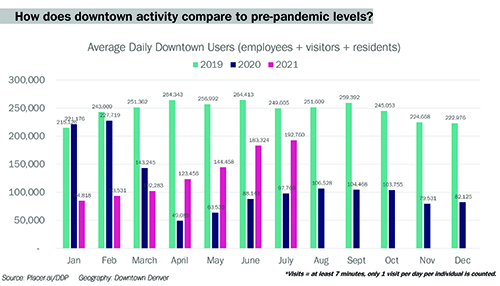
Charting Downtown Decline: Chart by the Downtown Denver Partnership compares downtown activity today compared to pre-pandemic levels.
District hotels also found that offering discount rates and unique package deals throughout the pandemic opened up new possibilities for value-conscious travelers looking to book an exceptional last-minute staycation. Deals included gift cards or complimentary passes to the district’s walkable dining, spa, fitness, and shopping options.
“We saw so many guests who had never stayed in Cherry Creek North before,” says the Jacquard’s Melissa Bush, Sales-Marketing Director. “People could suddenly get a luxury hotel experience at a price point that worked for them.”
Quick Recovery

Splish, Splash: Three Cherry Creek hotels feature rooftop pools to attract guests including this one at the Halcyon. Visitors are looking for more amenities, rather than conference rooms and convention spaces.
Now, rooms and occupancy rates in Cherry Creek North are nearing pre-pandemic levels, which is especially encouraging compared to hotel recovery nationally. A recent PricewaterhouseCoopers (PwC) report projects U.S. hotel occupancy this year to increase to 57.1%, with average daily room rates gaining 8%.
In Cherry Creek North, Duran reported that the Halcyon has exceeded financial goals for several months in a row, while JW Marriott’s McNamara saw steady and continued increases in both occupancy and average daily rate from June to November of 2020, with growth continuing this year.
Nick LeMasters, CEO of the Cherry Creek North Business Improvement District, believes the neighborhood “has emerged as a premier travel destination for people from near and far.” He adds that with five hotels, a high concentration and variety of restaurants and boutiques, and walkability of the area, “ It makes sense that people come to visit and end up staying.”
Glendale’s Allen emphasizes that, “The corridor along Cherry Creek streams from Glendale through Cherry Creek North, and now has enough hotel venues and dinner, sporting, and entertainment outlets to favorably compete with anybody in Colorado. These are very exciting times for this area.”

by Mark Smiley | Oct 22, 2021 | Main Articles
by Mark Smiley

Tickets Still Available: Tickets for the exhibit start at $39.99 and are available at www.denvervangogh.com.
The original Immersive Van Gogh exhibit launched on time and without delay on September 30, 2021, in Denver. The immersive exhibit highlights 400 of Van Gogh’s most famous paintings. It is housed at Lighthouse Denver at 3900 Elati Street, located in the former Regency Hotel, just west of the River North Art District (adjacent to I-25).
The Original Immersive Van Gogh Exhibit was designed by Massimiliano Siccardi and opened in Paris, where it attracted 2 million visitors. The exhibit merges video, animation, and other technology to offer something completely different than visiting a traditional art show.
The iconic Regency hotel plays host to this exhibit and provides guests with a new way to experience one of the world’s most iconic post-impressionist artists. “It’s truly a unique piece of art,” said Lighthouse Immersive Producer Corey Ross. “It ties together several things into what I see as a new genre. On one hand you have the art of Van Gogh on display. You also have an animated film. And then we have the experiential element of it. The public gets to walk through and choose their own experience.”
Rising to blockbuster status with over 2 million tickets sold, Immersive Van Gogh is proving to be one of the hottest shows sold-out in Toronto, Chicago, San Francisco, Los Angeles, and New York. With extended runs now available, audiences will have the opportunity to step into this historic space that has been transformed with Van Gogh’s paintbrush in a swirl of color, brought to life with over 90,000,000 pixels of animation spanning over 500,000 cubic feet of projection with 100 projectors.
Emmy Award-winning and Tony Award-nominated designer David Korins, known for his set designs, featured in numerous Broadway hits including Hamilton and Dear Evan Hansen, serves as the Creative Director for the Denver installation. Korins, who also served as Creative Director for the recently opened New York City exhibit, will design unique and experiential elements to transform Lighthouse Denver into a truly one-of-a-kind venue, crafting an experience unique to Denver.
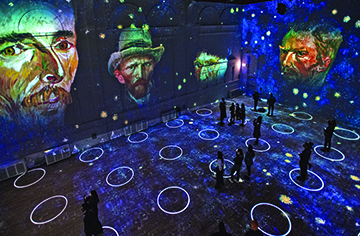
Technological Wonder: The Immersive Van Gogh Exhibit merges video, animation and other technology to offer something completely different than visiting a traditional art show. Photo Credit Michael Brosilow
“We have been delighted to see the way Immersive Van Gogh has been embraced by the city and people of Denver,” said Ross. One of every three residents of Denver has purchased a ticket making it a hot ticket in town.
“We’ve created a unique and enthralling production where Denver residents and visitors alike can quite literally surround themselves with the work of Vincent van Gogh, one of the greatest artists who ever lived,” added Producer Svetlana Dvoretsky.
“We all know that Van Gogh struggled with mental illness,” said Ross. “With depression, with isolation, with loneliness. I think coming out of the pandemic, more than ever, the public can relate to some of what he experienced, particularly the isolation and loneliness. Yet, here we are 130 years after he passed away [he committed suicide at age 37 in 1890], his pieces are known, are still beautiful to us, are colorful and uplifting, and most of all they transcend the difficult experience that he had. That transcendence, to me, is very cathartic to the public.”
Tickets start at $39.99 and the exhibit will run until at least February 6, 2022. For more information about Immersive Van Gogh, visit www.denvervangogh.com.


 Luminova Holidays at Elitch Gardens premiered on November 26, 2021, and runs through Sunday, January 2, 2022. For the first time ever, the park transformed into Luminova Holidays and delivered a winter wonderland experience with larger-than-life holiday displays featuring over three million lights and more.
Luminova Holidays at Elitch Gardens premiered on November 26, 2021, and runs through Sunday, January 2, 2022. For the first time ever, the park transformed into Luminova Holidays and delivered a winter wonderland experience with larger-than-life holiday displays featuring over three million lights and more.






















